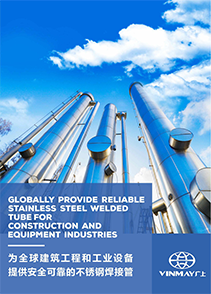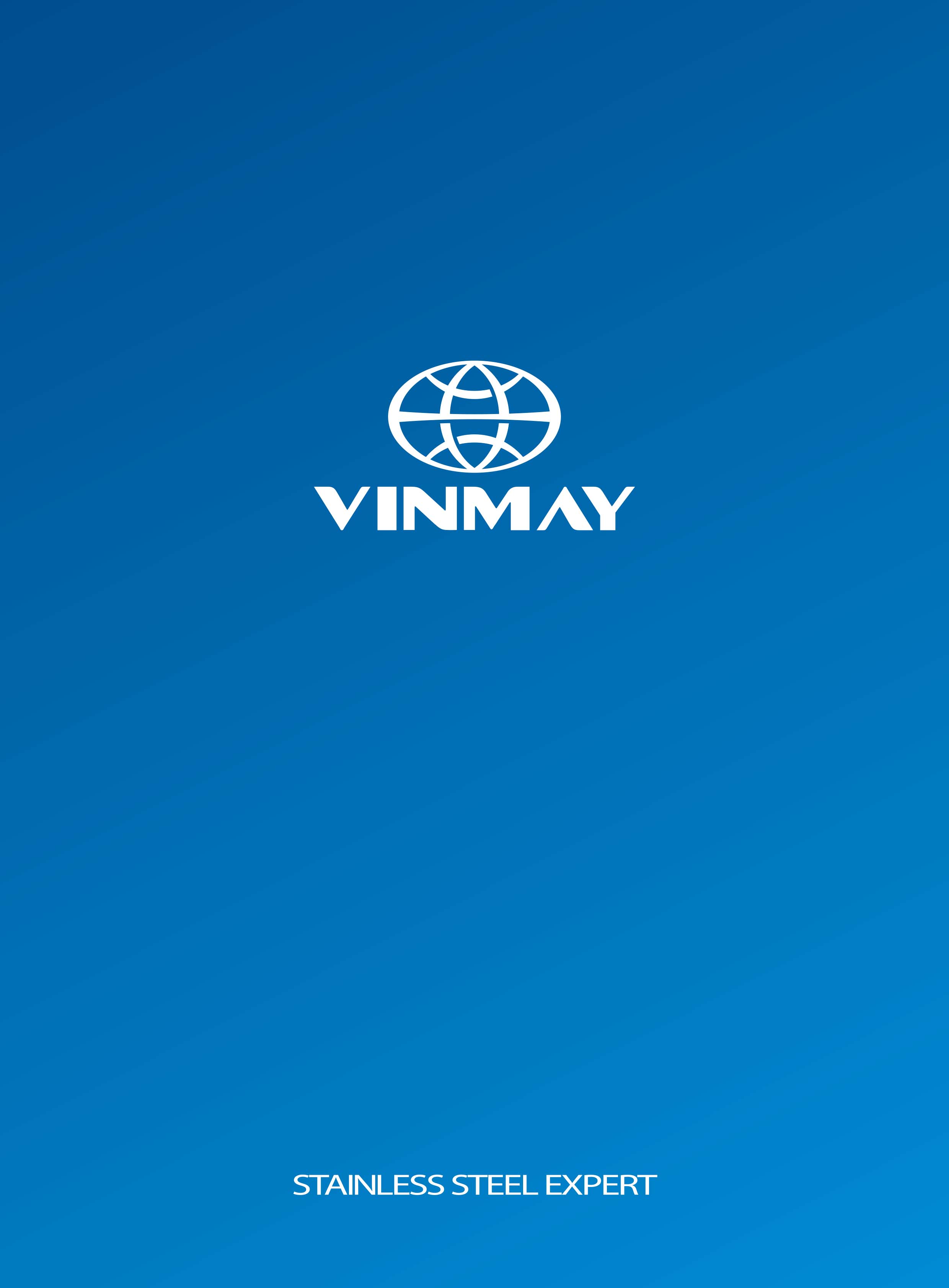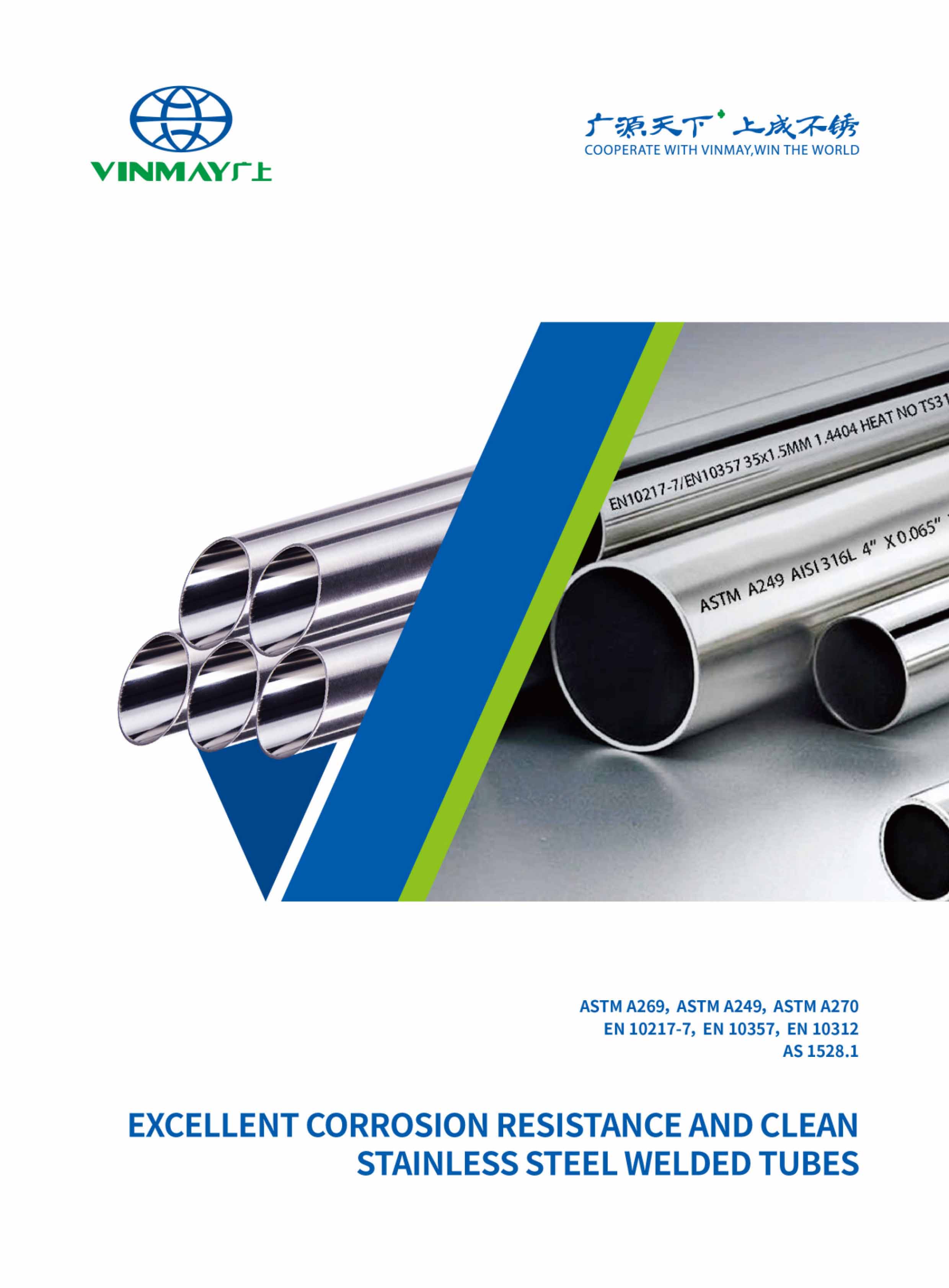Stainless steel, known for its exceptional corrosion resistance and strength, requires precise welding techniques in industrial fabrication and tubing. Gas Tungsten Arc Welding (GTAW) and Gas Metal Arc Welding (GMAW) are preferred for their ability to produce high-quality, durable joints. Mastery of surface preparation and joint design guarantees robust welds. The nuances of these methods offer a glimpse into the complexities of achieving industry-standard results. Discover more about overcoming challenges in this intricate process.
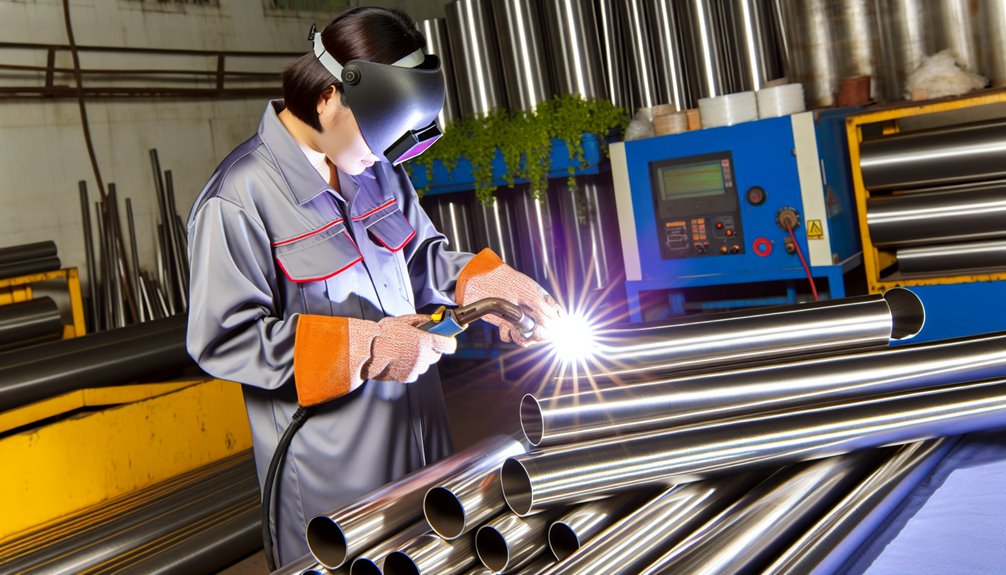
Stainless steel, an alloy primarily composed of iron, chromium, and nickel, exhibits distinct properties that make it a preferred material in various industries.
Its notable corrosion resistance is attributed to the chromium content, forming a passive layer that protects against oxidation and rust. This feature is essential in environments exposed to moisture and chemicals, ensuring durability and longevity.
Additionally, stainless steel's thermal conductivity is a significant factor, particularly in applications requiring efficient heat dissipation or retention. This alloy maintains structural integrity under temperature fluctuations, enhancing its utility in sectors such as construction, automotive, and food processing.
The precise control over these properties allows engineers and manufacturers to optimize performance while minimizing maintenance, confirming stainless steel's widespread industrial application.
Numerous welding techniques are employed for stainless steel, each suited to specific applications and material thicknesses.
Shielded Metal Arc Welding (SMAW), Gas Metal Arc Welding (GMAW), and Flux-Cored Arc Welding (FCAW) are prevalent methods. SMAW is favored for its simplicity and adaptability, while GMAW is efficient for thicker sections due to its continuous wire feed. FCAW, with its flux-cored wire, excels in outdoor conditions.
Welding safety is vital, necessitating personal protective equipment and proper ventilation to mitigate exposure to harmful fumes.
Joint design is essential, influencing weld integrity and performance. Butt, lap, and corner joints are common, each requiring precise preparation to guarantee peak fusion and strength.
Mastery of these techniques guarantees robust, high-quality stainless steel welds.
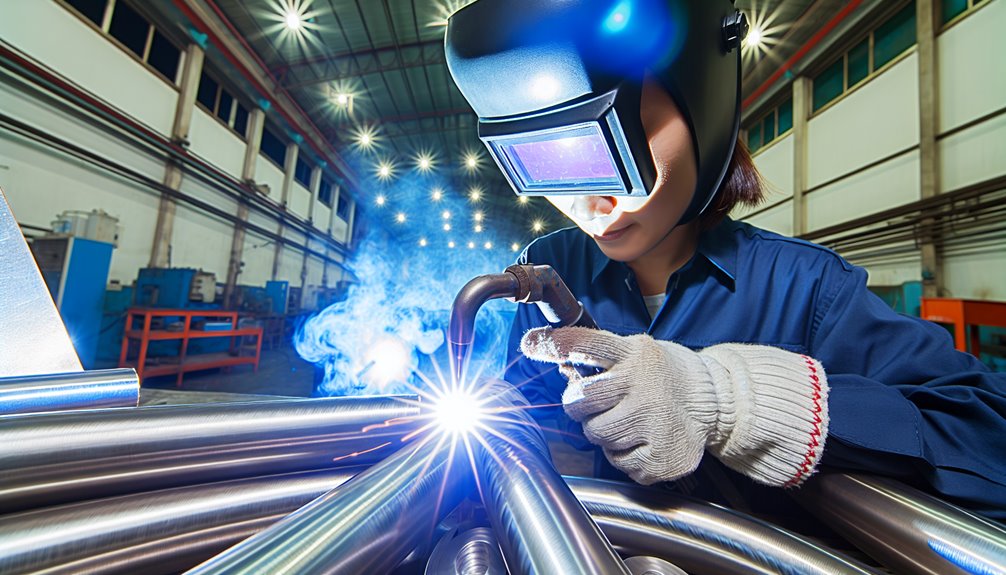
Among the various techniques for welding stainless steel, Tungsten Inert Gas (TIG) welding stands out for its precision and control. This process employs a non-consumable tungsten electrode, producing a high-quality weld with minimal distortion.
TIG welding offers distinct advantages, including superior weld aesthetics and the ability to weld thin-gauge materials with precision. Its low heat input reduces the risk of warping, maintaining the mechanical integrity of stainless steel.
TIG applications are extensive, spanning industries such as aerospace, automotive, and food processing, where precision is paramount. The controlled process allows for intricate welds in complex assemblies, making it ideal for critical projects.
TIG welding's ability to produce clean, defect-free welds highlights its importance in industrial fabrication and tubing.
MIG welding offers significant advantages regarding rapid weld completion, making it an ideal choice for projects requiring swift turnaround times.
Its ability to accommodate a broad range of material thicknesses enhances its versatility, allowing for seamless shifts between different stainless steel gauges without compromising weld integrity.
Additionally, the use of gas shielding in MIG welding provides superior protection against atmospheric contamination, ensuring high-quality welds with minimal defects.
Harnessing the speed and versatility of Metal Inert Gas (MIG) welding can greatly enhance the efficiency of welding stainless steel. This technique is essential for rapid weld completion, deploying rapid weld techniques that considerably reduce cycle times.
Efficiency improvement is achieved through continuous wire feed and minimal electrode replacement, ensuring consistent weld quality. The process utilizes an inert gas shield, typically argon or a mixture, to protect the molten pool from atmospheric contamination, vital for maintaining the integrity of stainless steel joints.
MIG welding is favored for its adaptability to varied operational conditions, offering precise control over weld parameters such as voltage and current settings. This precision facilitates robust penetration and consistent bead formation, aligning with stringent industrial fabrication standards.
When considering the material thickness range for MIG welding stainless steel, it is essential to understand the interplay between speed and versatility.
MIG welding is renowned for its ability to efficiently handle a wide spectrum of material thickness, from thin sheets to robust structural components. The technique’s adaptability aligns with stringent welding standards, ensuring consistent penetration and minimal distortion across varying thicknesses.
For thin materials, precise control of parameters such as voltage and wire feed rate is paramount, preventing burn-through while maintaining weld integrity.
Conversely, for thicker sections, adjustments in amperage and travel speed are vital to achieve adequate fusion and compliance with industry standards.
Mastery over these variables empowers operators to optimize weld quality and efficiency, catering to diverse industrial applications.
Gas shielding plays a critical role in the efficacy of MIG welding, ensuring ideal weld quality by protecting the molten weld pool from atmospheric contamination. This protective layer prevents oxidation and other detrimental reactions that could compromise the structural integrity of the stainless steel welds.
The welding benefits of employing gas shielding in MIG welding are numerous and significant:
These advantages make MIG welding a preferred method for stainless steel fabrication.
Stick welding, also known as Shielded Metal Arc Welding (SMAW), is characterized by its straightforward setup, requiring minimal equipment such as a power source, electrode holder, ground clamp, and consumable electrodes.
This welding technique offers notable advantages, including portability and the ability to perform in various environments, making it particularly suitable for fieldwork and repairs.
However, practitioners may encounter challenges such as slag inclusion and electrode sticking, which necessitate skillful handling and consistent practice to guarantee high-quality welds.
Essential tools form the backbone of successful stick welding for stainless steel, offering simplicity and accessibility to both novice and experienced welders.
Guaranteeing welding safety and ideal equipment maintenance are paramount in achieving high-quality results. The following essential equipment is indispensable for effective stick welding:
Proper attention to these elements guarantees a controlled and efficient welding process.
With a foundation built upon essential equipment, the inherent advantages of stick welding for stainless steel emerge prominently.
Stick welding benefits include simplicity in operation and minimal equipment requirements, making it ideal for varied environments. The adaptability of stick welding applications extends across outdoor conditions and diverse positions, ensuring successful stainless steel joints even under challenging circumstances.
Its robustness allows for effective use in maintenance, repair, and heavy industrial contexts, where portability and flexibility are paramount. The process accommodates a range of electrode types, enhancing versatility in welding different stainless steel grades.
Additionally, stick welding's inherent capability to work with moderate surface contaminants offers practical advantages, reducing the need for extensive pre-cleaning. This method, consequently, remains a trusted choice for controlled, efficient stainless steel fabrication.
Although stick welding offers numerous advantages for stainless steel applications, it is not without its challenges. Precision in technique and equipment handling is imperative to minimize welding defects.
Here are three common challenges faced:
These challenges necessitate a thorough understanding of welding techniques and post weld treatments.
When selecting the appropriate welding method for stainless steel, understanding the material's unique properties is crucial. Various welding techniques cater to different project requirements, guaranteeing ideal results. Key methods include Gas Tungsten Arc Welding (GTAW), Gas Metal Arc Welding (GMAW), and Shielded Metal Arc Welding (SMAW). Each technique offers distinct advantages based on specific criteria such as strength, corrosion resistance, and application setting.
| Welding Technique | Advantages | Application |
|---|---|---|
| GTAW | Precision, Clean Finish | Pipe Fabrication |
| GMAW | Speed, Versatility | Structural Work |
| SMAW | Simplicity, Portability | Outdoor Projects |
Professionals must weigh these factors against project requirements to determine the most suitable method. Expertise in matching technique to requirement guarantees structural integrity and longevity. Selecting appropriately increases efficiency and minimizes material distortion, crucial in industrial fabrication and tubing.
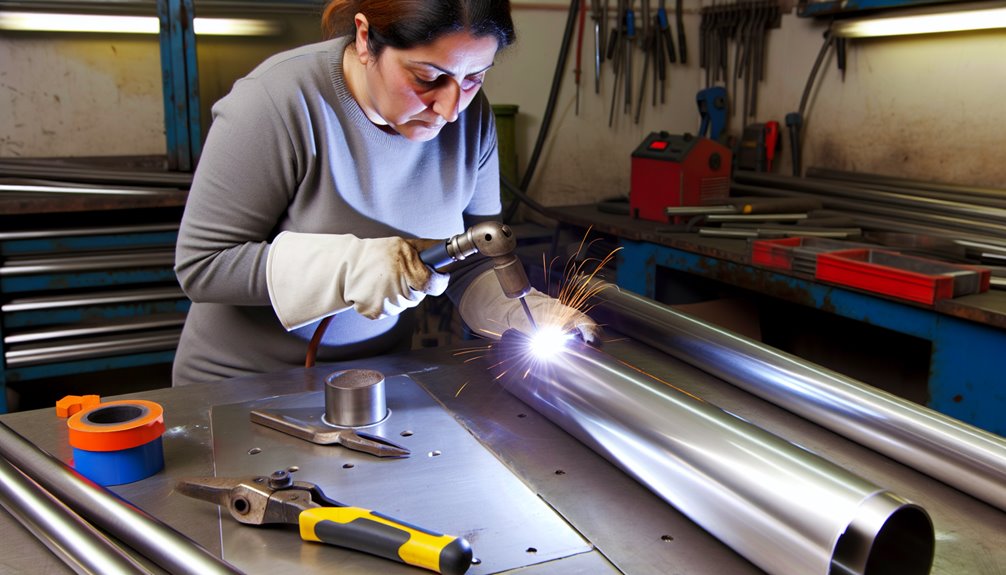
Proper preparation of stainless steel is fundamental to achieving optimal welding results. Ensuring ideal cleanliness and precision in joint preparation is essential for high-quality welds. The following steps offer a structured approach:
Adhering to these detailed procedures enhances control and predictability in welding stainless steel.
Welding stainless steel presents distinct challenges, including heat distortion, which can alter the material's structural integrity and dimensional accuracy.
Ensuring corrosion resistance is critical, as improper welding techniques may compromise the protective chromium oxide layer.
Additionally, material compatibility issues often arise when dissimilar metals are joined, necessitating careful selection of filler materials and welding parameters to maintain joint integrity.
Due to the unique thermal properties of stainless steel, heat distortion is a prevalent challenge encountered during the welding process. This issue arises from the material's low thermal conductivity and high coefficient of thermal expansion, necessitating precise distortion mitigation techniques.
Effective heat distortion prevention is vital for maintaining dimensional accuracy and structural integrity in stainless steel applications.
To address this challenge, professionals employ several strategies:
Implementing these measures is fundamental for achieving high-quality welds and maintaining stringent tolerances, and as a result, guaranteeing peak performance in industrial fabrication and tubing applications.
Corrosion resistance remains one of the most challenging aspects when welding stainless steel, demanding meticulous attention to detail and technique.
Welding can compromise the passive oxide layer that imparts corrosion resistance, leading to various corrosion types such as pitting, crevice, and intergranular corrosion. These issues necessitate precise preventive measures to maintain the integrity of the material.
Guaranteeing a clean working environment and using high-purity shielding gases are essential steps to minimize contamination risks. Controlling heat input through precise welding parameters helps preserve the microstructure, reducing susceptibility to corrosion.
Post-weld treatments, such as passivation, can restore the protective oxide layer. A disciplined approach to welding practices guarantees that the corrosion-resistant properties of stainless steel are preserved effectively.
When addressing material compatibility challenges in welding stainless steel, understanding the metallurgical properties of the base and filler materials is paramount. Effective material selection criteria must consider thermal expansion, corrosion resistance, and mechanical strength. Compatibility testing methods are employed to guarantee that the chosen materials will not compromise the weld integrity.
To maintain control over the welding process, careful attention must be given to the following:
These measures are essential in overcoming material compatibility challenges in stainless steel welding.
Achieving weld quality and integrity in stainless steel fabrication demands meticulous attention to various essential factors, including weld preparation, selection of appropriate filler materials, and adherence to stringent procedural guidelines.
A thorough weld inspection protocol is critical to guarantee structural soundness and compliance with industry standards. Quality assurance measures, such as non-destructive testing (NDT) techniques, play a pivotal role in detecting potential defects, including porosity, cracks, and incomplete fusion.
Precise control over welding parameters, including heat input and travel speed, is key to prevent distortion and maintain the desired corrosion resistance of the stainless steel.
Documentation of welding procedures and operator qualifications further reinforces quality management systems, assuring consistent performance and reliability across fabrication processes.
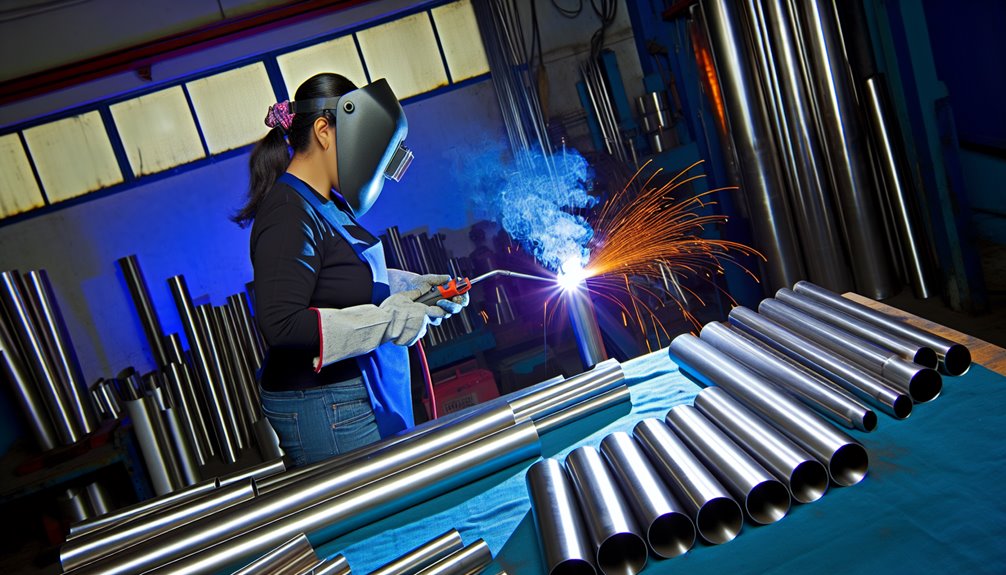
Widely recognized for its exceptional corrosion resistance and mechanical properties, stainless steel is a preferred material in various industrial applications, ranging from the construction of chemical processing equipment to the fabrication of sanitary piping systems.
Welded applications of stainless steel are integral in numerous industrial uses due to its ability to maintain structural integrity under adverse conditions.
Key industrial applications include:
These applications underscore the material's versatility and reliability.
Welding stainless steel, ironically akin to a blacksmith's dance with rust demons, can compromise corrosion resistance. The disruption of protective oxide layers initiates corrosion mechanisms, necessitating weld passivation to restore surface integrity and maintain its anti-corrosive prowess.
Essential safety equipment for welding stainless steel includes proper protective gear such as welding helmets with appropriate filter lenses, flame-resistant clothing, heat-resistant gloves, and adequate ventilation systems to mitigate harmful fumes, ensuring safe and controlled welding techniques.
Yes, welding stainless steel can release harmful fumes. Fume exposure encompasses potential health risks, including respiratory issues due to hexavalent chromium and nickel compounds. Implementing adequate ventilation and protective equipment is essential for controlling these hazards effectively.
Like a maestro orchestrating harmony, preventing warping in stainless steel involves preheating techniques to evenly distribute heat and controlled cooling methods to manage contraction. Precision in temperature management guarantees structural integrity, mitigating distortion during the welding process.
Yes, specific welding consumables exist for stainless steel. Selecting appropriate welding rods and filler materials, such as those matching alloy composition, guarantees ideal joint integrity and corrosion resistance, essential for precise industrial fabrication and tubing applications.
In the domain of industrial fabrication and tubing, welding stainless steel is akin to threading the needle, demanding precision, expertise, and meticulous preparation. Employing techniques such as TIG and MIG welding guarantees robust, corrosion-resistant joints, critical for complex structures in demanding environments. By overcoming challenges like thermal distortion and chromium carbide precipitation, professionals can maintain weld integrity. Ultimately, mastering these advanced techniques secures the structural backbone of industry, assuring reliability and longevity in every project.
For projects requiring high-quality, reliable stainless steel welded tubing, Vinmay provides certified solutions engineered to meet stringent industrial standards. Whether your focus is on marine, chemical, or structural applications, our tubing is designed to support optimal welding performance and long-term durability.
Explore our products or contact our technical team today to discuss your specifications and ensure your next project achieves the highest standards of quality and reliability.
